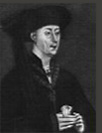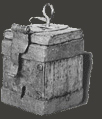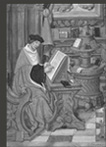 The best known "Maître Ecrinier" ** was Aristide Chombier (1225), brother of the famous musician, lyric writer and poet François Chombier (1217). A. Chombier was born in the small village of Loustac near by Nantes, and spent a quiet childhood in a small family house, surrounded by the care of his parents, brothers and sisters. In spite of aptitude for drawing and handcraft, his schooling rate was average and he left school at 13 years to become an apprentice of the village cooper. He quickly left the statute of apprentice to become a fellow, but the barrel workshop soon left his mysteries and he decided, at the age of 17, to leave to discover the world. He stayed a little in Nantes, working from time to time for a cabinetmaker. He spent most of his time in the tavern "The Merry Tankard", where he lived a windy and wet attic, emptying beer tankards with idle sailors and noisy wives and harlots. Hunted down by a bunch of angry husbands, Aristide Chombier discreetly left Nantes to reach Paris, having only left few sketches and drafts. His stay in the capital was uneventfull and after a few months, he left to the south of France. This travel was decisive for his inspiration as he regained the taste for drawing when in the countryside. At this time, he produced the first sketches for his famous jewel cases. He spent a few months travelling from cities to villages, sleeping outside or sometimes in a barn, if he could find work in a farm. At the end of this piecefull time, he reached Marseille. There, he met Rose Dalambert and the course of his life compliquely changed. He married Rose in Toulouse in 1249 and the young couple moved to a small village house down the city wall of Carcassonne.
The best known "Maître Ecrinier" ** was Aristide Chombier (1225), brother of the famous musician, lyric writer and poet François Chombier (1217). A. Chombier was born in the small village of Loustac near by Nantes, and spent a quiet childhood in a small family house, surrounded by the care of his parents, brothers and sisters. In spite of aptitude for drawing and handcraft, his schooling rate was average and he left school at 13 years to become an apprentice of the village cooper. He quickly left the statute of apprentice to become a fellow, but the barrel workshop soon left his mysteries and he decided, at the age of 17, to leave to discover the world. He stayed a little in Nantes, working from time to time for a cabinetmaker. He spent most of his time in the tavern "The Merry Tankard", where he lived a windy and wet attic, emptying beer tankards with idle sailors and noisy wives and harlots. Hunted down by a bunch of angry husbands, Aristide Chombier discreetly left Nantes to reach Paris, having only left few sketches and drafts. His stay in the capital was uneventfull and after a few months, he left to the south of France. This travel was decisive for his inspiration as he regained the taste for drawing when in the countryside. At this time, he produced the first sketches for his famous jewel cases. He spent a few months travelling from cities to villages, sleeping outside or sometimes in a barn, if he could find work in a farm. At the end of this piecefull time, he reached Marseille. There, he met Rose Dalambert and the course of his life compliquely changed. He married Rose in Toulouse in 1249 and the young couple moved to a small village house down the city wall of Carcassonne.
Aristide established his workshop in a barn in his backyard and began the produced his first jewel cases. Obviously, even if the making was of hight quality, his first jewel cases didn't reach the quality level of those he had drawn during his travel. However, his skill was quickly recognised and orders flew. The small workshop was fast overflowed and he decided to create a new workshop in a closeby house. At this time, he met the young sculptor David Baroga and he started creating his first luxurry jewel cases. The workshop homed up to ten apprentices and fellows and his fame largely exceeded the south of France.
After a few years, he withdrew in his private drawing workshop, at the back  of his garden. He entrusted the management of the jewel cases workshop to his friend David Baroga and spent his time exclusively creating original designs. From this time, he carved himself his jewel cases. These were so invaluable that it could take more than one year of assiduous work to produce a single case. Today, Aristide Chombier's jewel cases are extremly rare and highly sought for by worldwide medieval experts. Among the best jewel cases, his well-known "Ecrin de Termidor" reached outrageous prices at London, then New York auctions. The worshop doesn't exist any more, but one can still see the plaque in a Carcassonne house. Paul Chombier, descendant of Aristide Chombier, still owns the family house and his ancestor's private drawing workshop in the back garden which has been turned into a private museum.
of his garden. He entrusted the management of the jewel cases workshop to his friend David Baroga and spent his time exclusively creating original designs. From this time, he carved himself his jewel cases. These were so invaluable that it could take more than one year of assiduous work to produce a single case. Today, Aristide Chombier's jewel cases are extremly rare and highly sought for by worldwide medieval experts. Among the best jewel cases, his well-known "Ecrin de Termidor" reached outrageous prices at London, then New York auctions. The worshop doesn't exist any more, but one can still see the plaque in a Carcassonne house. Paul Chombier, descendant of Aristide Chombier, still owns the family house and his ancestor's private drawing workshop in the back garden which has been turned into a private museum.
If you are interested by the life of Aristide Chombier and his jewel cases, you can refer to several books:
- "Ecrins et coffrets anciens" by René Lattand, éd. Laffont, 1978
- "La Manufacture Chombier" by Paul Chombier, éd. Konemman, 1982
- "Les Maîtres Ecrinier" by Louis Poralis, éd. La Chandelle, 1965
* From the book "Les Maîtres Ecrinier" by Louis Poralis, éd. La Chandelle, 1965
** Ecrinier: n.m. (Latin: escrinium) craftsman specialised in the design of jewel cases or precious boxes made out of wood and sometimes small "objets d'art".

